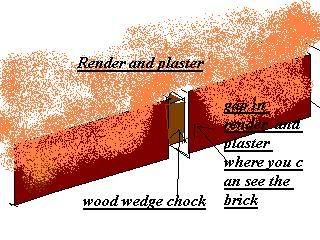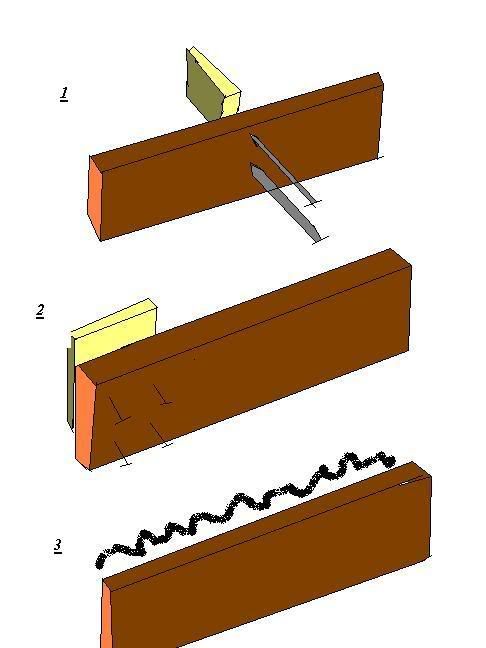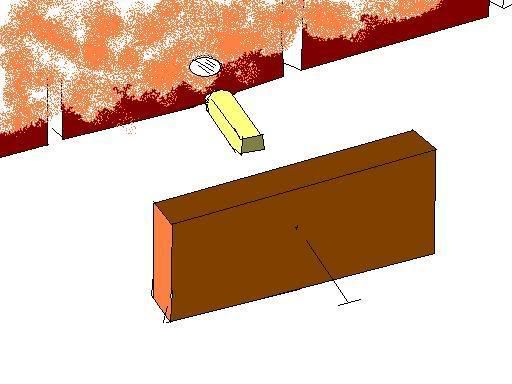Results 1 to 7 of 7
Thread: securing new skirting boards
-
23rd November 2007, 02:54 PM #1
 Novice
Novice











- Join Date
- Nov 2007
- Location
- Adelaide
- Posts
- 12
 securing new skirting boards
securing new skirting boards
Hi guys, i have just come across this forum and thought "wow" this looks to be much better than the book i picked up from the library.
I am reading through all 16 pages of threads in this topic looking for what i am doing (currently i am up to page 5...i read slow ).
).
Anyway, to stop the dribbling, My GF and myself are currently renovating a home we just bought. It is a solid brick interior home so to my knowledge the walls are red brick internal, then covered in a render, then covered in a plaster. The render and plaster coats probably amount to about a centimetre's worth of thickness.
We have removed the skirtings and architraves along the bottom as they were old looking and hideaously painted and we intend to put new meranti skirtings down.
I am trying to look on the best, most practicable way to reseat the skirtings against the wall.
Unfortunately i don't have a camera so you will have to bear with me with some ms paint pictures.
The existing setup had the skirtings attached to the wall using chocks inserted into the gaps between the bricks on the bottom row where mortar wasn't put in. When the home was plastered it looks like they just went around these chocks. kind of something like this first picture

i am trying to work out the best way to put the new ones back on.
From what i have read so far there looks like there is 3 ways.
1. reinstall as it was removed. This means i would have to remove the existing chocks in the wall (they would be quite useless to put another nail into). remaking new ones to be equally as tight and annoying to remove. mark the wall or floor with a light marker for me to indicate where the chocks are reinstall skirtings and hammer nails in the general vicinity of these chocks.
2. clear away a piece or render so i can see the brick completely. Attach a 9mm piece of wood to the brick (how? with masonary nails, spaghetti tube and screws, construction adhesive, dyna bolts etc.) this wood would be roughly the same thickness as the render. then when attaching the skirtings i can roughly aim for this piece of wood and also use a lighter guage nail, but a few more of them (to account for the lesser thickness in the wood)
3. plaster the wall fully behind so it is smooth from ceiling to floor and then use construction adhesive to secure into place.

They all seem to have their pro's and cons, but i don't know which is the accepted way or the best way to do it.
1. is just replicating what was already done, it seems like a lot of work to make so many chocks, remove the existing ones and get them to wedg good so the don't fall out or come loose.
2. seems like the easiest way, the wood hight has to be less than the skirtings to avoid seeing it securing it might be a problem and becuse of the depth securing the skirtings to it might also be a problem, could be supplemented with adhesive.
3. looks to be easiest. simply repatch wall and glue into place. but my experience of glue i am concerned it would come away or bow or i would be contorting many a method to hold the skirt in place while i waited an eternity for the adhesive to set.
Obviously i don't plan to remove the skirtings down the track, but some of the rooms have power points in them so i might need to get behind them for some reason. as long as the skirtings stay reasonably intact when removed so they can be reused would be my main concern (imo i could fix the wall cheaper than replace the length of skirting). Can the adhesive be easily removed from the back of the skirting if this method was chosen?
are there any other methods i should be looking at, is there still a thread that has all this answered but i just haven't found that one yet? (i read a lot about wether to butt it to the ground or leave a gap though).
Cheers in advance for your help.
Regards
Damien
-
23rd November 2007, 04:30 PM #2
 Awaiting Email Confirmation
Awaiting Email Confirmation











- Join Date
- Jan 2007
- Location
- Goulburn NSW
- Age
- 89
- Posts
- 7

They are called skirting plugs and the way that they were made ........
cut maple about 3 inches long and with a benchman's side hatchet split into random widths they then shaped on one end with a cut on each side,... looking down the shape ,it resembled a propeller.So when you drove it in it twisted to tighten it. With a bag full of plugs you put one in every second brick joint, cut the plug off flush with the wall, marked its position on the floor. Then they were rendered over. If you are going to replace them I would be very wary , there might be a plug in the same brick joint on the other side of the wall. The bricks could move. I think the method of fixing will be determined by the condition of the bricks. If the existing plugs are still tight I would cut some cedar in a round shape bigger that the nail holes and with some glue belt them in. If you want to remove them split them into pieces with a 1/4 inch chisel
les
-
23rd November 2007, 10:35 PM #3
 SENIOR MEMBER
SENIOR MEMBER











- Join Date
- Apr 2005
- Location
- Sydney
- Age
- 64
- Posts
- 882

Good advice from les88 there.
If you're painting the skirting then I'd just drill straight through the skirting, and into the bricks with a long 5.5mm masonry bit, then insert a piece of spaghetti all the way, then withdraw it a couple of mm, then cut it off flush with a chisel, then tap it under the surface with the head of a nail before driving a 75mm x 3.75mm bullet head nail in, then punch the nail. If you don't ensure that the spaghetti is below the surface before nailing, then it will most likely stick out proud after nailing, and it will be difficult to camouflage it with putty.
If you're lacquering the skirting, then it's desirable to have the smallest hole possible, so I'd use 65mm x 2.5mm gauge bullet head nails. Drive the nails in at about 600mm centres, deep enough to mark the render on the wall. Remove the skirting and with a 10mm masonry bit, drill holes in the wall at the nail marks, 50mm deep. With a piece of timber 10mm thick, by at least 50mm long, use a chisel to split square plugs 10mm x 10mm x min 50mm long. Chisel a bit off the corners (but not too much), then drive them into the round holes and cut them flush with a hand saw or chisel. Replace the skirting and drive the nails home. If it's a wide skirting, then you may need to nail it near the top as well as the bottom. You may be able to drive nails on an angle down into the floor if the floor is timber. It would be best to use a bit of max bond as well, but it should stay put without it. If you don't use glue then it would be easier to remove the skirting if you have to.
As for the gap, some will disagree as they have in the past, but if you're installing carpet then there's no reason that you can't lift the skirting 10mm to get maximum visible depth of skirting. If it's polished timber floor, or floor tiles, then scribe the bottom edge of the skirting by running a pencil along the floor, marking the skirting to the shape of the floor. Use a planer to plane to the mark so the skirting will fit tight against the floor.
Cope the internal joints by cutting a mitre, and following the edge of the mitre with a coping saw. Undercut the joint so that it's tight at the front edge.
I'm happy to go into more detail if you don't understand.
-
24th November 2007, 09:02 AM #4
 Novice
Novice











- Join Date
- Nov 2007
- Location
- Adelaide
- Posts
- 12

cheers for the help guys, i didn't know if this post was going to make it on here as i had a bit of trouble first time trying to submit it.
les88: I am not entirely sure on the condition of the lower rung of bricks where the skirting plugs are. Some of them are definately wedged in there real good, but don't have a suitable hole to reuse them (unless i do as you mention and knock some cedar into the holes). i tried pulling a few out by driving a screw into them and then using a claw hammer to pry them out but was unuccessful and the wood just kept on giving way. I guess that explains why there was no render over the plugs. as the render would have cracked and broken off as the nails were driven through it and most probably fell down under the floorboards.
pawnhead: if i am reading correctly, is this what you are recommending?:

the skirtings will be laquered
-
24th November 2007, 12:39 PM #5
 SENIOR MEMBER
SENIOR MEMBER











- Join Date
- Apr 2005
- Location
- Sydney
- Age
- 64
- Posts
- 882

Yeh that's it.
If you use a small nail of about 2.5mm gauge then the hole will be very unobtrusive once it's puttied up, and if you use galvanised nails, then their rough texture will hold better in the timber plug.
Before you drill the holes in the masonry, drive all the nails through the skirting whilst holding it in place on the wall. They will leave marks on the wall that will show you exactly where to drill. Try to locate them in a brick because the plugs will hold better than if they are in the mortar joints.
With your chisel, cut the corners off the square dowel to make it a hexagonal shape that's slightly larger than the hole. If your wall has been built with weak lime mortar, then it may cause damage by pounding an oversized dowel into it.

In this case, chisel the dowel so that it's smaller than the hole and glue it in with some max bond. Leave it overnight to dry before nailing the skirting in place.

Last edited by pawnhead; 24th November 2007 at 12:42 PM. Reason: Clarification
-
24th November 2007, 02:19 PM #6

-
24th November 2007, 04:58 PM #7
 SENIOR MEMBER
SENIOR MEMBER











- Join Date
- Apr 2005
- Location
- Sydney
- Age
- 64
- Posts
- 882

You're right there since there's already spaces there for them.
If it was a new wall then drilling dowels would be the go though.
Similar Threads
-
Cutting Scribed internal corners on skirting boards.
By bpj1968 in forum DOORS, WINDOWS, ARCHITRAVES & SKIRTS ETCReplies: 6Last Post: 26th September 2007, 07:02 PM -
Lino floors and skirting boards
By peter_sm in forum PAINTING, PLASTERING, TILING, DECORATING, etc.Replies: 5Last Post: 27th February 2007, 03:46 PM -
where to buy skirting boards in Canberra?
By Trav in forum DOORS, WINDOWS, ARCHITRAVES & SKIRTS ETCReplies: 3Last Post: 28th November 2005, 06:51 PM -
Gluing skirting boards
By Marc in forum DOORS, WINDOWS, ARCHITRAVES & SKIRTS ETCReplies: 16Last Post: 31st January 2005, 10:32 PM




 Reply With Quote
Reply With Quote



Bookmarks